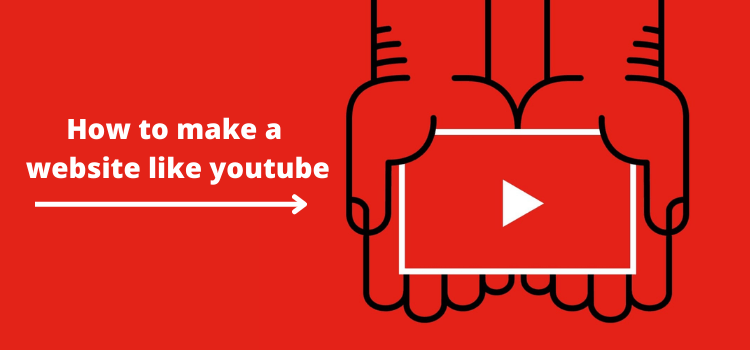Video hosting is a site through which you can download and view videos in your browser using a special player. Video hosting became popular with the spread of broadband access to the World Wide Web.
Any user visiting the video hosting can watch any video and write a comment about it. Development of video hosting is quite a costly idea, just because it is necessary to save a huge amount of information, subject to moderation due to the need to follow the laws and public morals. However, it is possible to make a website with video hosting if you want to. It is only important to constantly work on it. How to make a website like youtube?

Then your idea will not be utopian and will bring income. Think about the success of YouTube. He made a real revolution. Already in the year of its creation, it surpassed the total traffic of the Internet in the United States. Today, two billion users visit the video hosting service every day.
And it all started with the idea of two American guys. Chad Harley and Steve Chen decided to make a website in 2005. After looking at the profitability of the project, Google bought it for $1.6 billion, putting Hurley in charge of the corporation. Is it realistic to repeat the success of YouTube and make a website at least of its level, and ideally the next generation?
Today, video hosting has become a tool that many people use to make money from their videos. How can you make money with your own video hosting? It’s enough to understand a simple truth: all the media space in the world is based on advertising.
The higher the ratings, the more income. A simple formula. But its implementation requires a lot of effort and work. You can start today: developing a platform is your first step.
Why would you make a website with a new video hosting service when you have Youtube?
Unpleasant situations happen every day. Often among the companies affected by Youtube sanctions are video news channels. Editorial boards pull out exclusive materials, sending their best camera operators and correspondents to the hot spots, and YouTube takes it and blocks the channel.
Regarding blocking channels, YouTube tries to do it only when it violates copyrights. It’s hard to understand why YouTube behaves this way towards companies which never infringe copyright.
Today, it’s beneficial to have your own video hosting service that won’t suffer because someone decides your content is inappropriate or violates “community norms.” Because of common negligence and unprofessional decisions, many large companies lose their content investment.
Video hosting is a great tool for users with their own businesses. Using video hosting, you can promote and promote your project well.
Make a website on Youtube: Advantages of personal video hosting
- You can’t be banned from showing your video, even if you have reasons for it, which means you won’t face a “ban”.
- Your video can be used as an SEO tool to rank in the top search results and drive traffic to your sales page. You get all the rights and opportunities in one day to become a ranking site in the Google search engine.
- Effectively and targeted traffic to your advantage, keeping your customers.
- Preserving your video content and your video investment.
The biggest benefit of having your own video hosting site is the ability to monetize your content. If you’re using existing major platforms like YouTube, you can’t set your own payment terms.
Plus, everyone has access to your content. With subscriptions, you can generate revenue directly, and at the same time you’ll have customer information and contact information.
And of course you can control who can see your content. Another advantage is that you determine the content of your platform yourself, rather than following the recommendations of others.
How to make a website that will be a successful new video hosting site?
Let’s learn how to make a website that will be your own video hosting site. Over-the-top content can be a very successful business model and is becoming increasingly popular.
What is over-the-top content?
OTT for short is a way to make video and audio content available over the Internet. Previous forms of television, such as cable, satellite and IPTV, differ in that the service provider creates the infrastructure themselves, and decides what to include and at what time.
But using video-on-demand, the user decides when and what to watch, unlike cable or satellite television. With OTT content, the providers simply use the Internet for transmission and are responsible for the copyright, the demo, and the possible distribution of the content.
A well-known example: Netflix
Netflix is a very good example of OTT. The streaming service allows you to watch a variety of movies and TV series — when and as much as you want. Netflix has movies and series that you can watch anywhere. In 2021, this provider had 209 million paid subscriptions — and the trend is growing.
Netflix’s competitors are Amazon Prime, Disney + and Apple TV, for example. You can make a website and offer OTT content on your own platform. There are three different models.
- Free content
With free OTT content, you can increase traffic to your site. More traffic usually leads to more conversions, which can increase your sales. At the same time, you can place ads or integrate with affiliate programs.
- Paid Content
A paid subscription model, make users pay for your content and you will directly generate revenue. Then your customers will have access to the view as long as they are members.
- Freemium content
With a combination of free and paid content, you can have it both ways. Like the music streaming service Spotify does.
On the one hand, you can make money directly through subscriptions, while at the same time increasing the number of users through free content.
What kind of videos should be on your own platform?
There are virtually no restrictions on the type of video. Only one thing is important: You have to offer the audience real value. Otherwise, viewers will likely not return or cancel their membership. For example, your videos should be highly entertaining and educational — well, or both.
Examples of possible video types:
- Video courses and webinars.
- Tutorials.
- Movies and TV series.
It’s important that you identify your target group and tailor your content to your niche. There are countless topics for OTT content, such as:
- Sports programs or tutorials
- Nutrition and cooking videos
- Programming Courses
- Language Courses
- Software Tutorials
- And much more!
Are there risks?
Although the odds seem tempting, you should be aware of the minuses as well. For one thing, you should definitely pay attention to licenses and copyrights. It is not only about the videos, but also, for example, about the background music in the recordings.
Another risk is other creators of OTT content. If there are so many offers, customers choose one or more platforms. This mainly applies to subscription models and interesting and engaging content. It can also be difficult to make a website as an analogue of Youtube, since big services are already well known.
Remember, time is working against you. So this is where you have to hurry to make a website, which will become a replacement for the well-known video hosting service. Tomorrow your ideas may be realized by someone else. The craziest concepts have become profitable global projects.






Leave a Reply